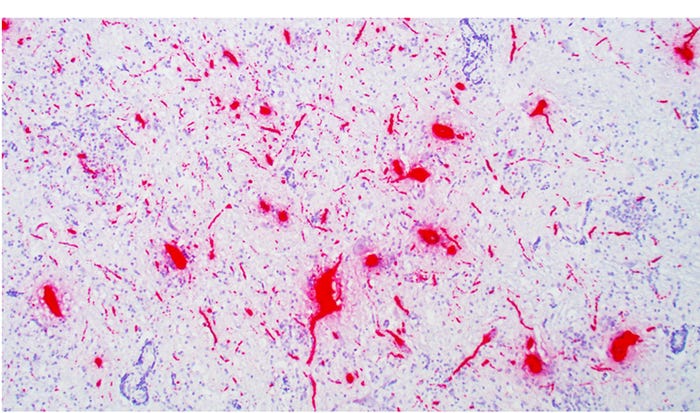Nursery and sow mortality of flows affected with PoAstV3 neurologic disease has been commonly reported to be 3-5% and 5-7%, respectively.
November 6, 2018

By Gaurav Rawal, Franco Matias Ferreyra, Grant Allison, Adam Mueller, Nubia Macedo, Laura Bradner, Karen Harmon, Daniel Linhares and Bailey Arruda, Iowa State University
Astroviruses cause disease in numerous animal species, including humans. Recently, porcine astrovirus type 3 has been associated with outbreaks of neurologic disease in swine in the United States. Despite the number of species infected, we know very little about a majority of astroviruses.
Diagnostic cases
Historically, PoAstV3 neurologic cases have been uncommon (Figure 1). There has been a considerable increase in the number of cases submitted to the Iowa State University Veterinary Diagnostic Laboratory in 2018 (Figure 1). PoAstV3 can cause neurologic disease in pigs at varying stages of production including recently weaned pigs, finishing pigs and adult females.
PoAstV3 is the most commonly identified cause of neurologic disease in sows at the ISU-VDL. The increased frequency of diagnosis of PoAstV3 neurologic disease in recent years suggests PoAstV3 is affecting more farms, systems or flows than in the past.

Figure 1: Frequency of detection of porcine astrovirus type 3 in cases of neurologic disease at the Iowa State University-Veterinary Diagnostic Laboratory using qPCR. The X-axis indicates the year of detection. The Y-axis indicates the number of cases positive by qPCR.
Clinical signs
Pigs affected with PoAstV3 are commonly found lying on their side and unable to walk. Less severely affected pigs have difficulty walking and often knuckle over on the forelimbs, as seen in the video below. Affected animals commonly appear unable to bear weight with their legs and, if able to move, sometimes “crawl” with their abdomen near or touching the ground. Affected pigs are generally aware of their surroundings and remain responsive to visual stimuli or sounds. They may try to eat and drink if individually provided feed and water in an “intensive care” environment. Importantly, however, these peculiar signs do not distinguish neurologic disease due to PoAstV3 from neurologic diseases due to other viruses or insults. Note that “paddling” is not a characteristic sign of neurologic disease due to this type of viral agent that is primarily affecting spinal cord functions. Duration of clinical signs in individual pigs is commonly less than four days, with many euthanized based on welfare concerns.
Herd impact
Nearly all animals that develop clinical signs will die. Affected farms commonly report nursery mortality to be 3-5%; similar to other viral causes of neurologic disease. When sows are involved, mortality may be 5-7%. Sows at varying parities are commonly affected. Clinical disease in a group of pigs commonly spans weeks. Veterinarians dealing with the disease often indicate a high recurrence rate.
Key findings
PoAstV3 is an emerging cause of neurologic disease of swine at various stages of production.
Nursery and sow mortality of flows affected with PoAstV3 neurologic disease has been commonly reported to be 3-5% and 5-7%, respectively.
Case fatality rate is close to 100%.
Animals are commonly found on their side but are aware of their surroundings. Less-affected pigs appear unable to bear weight and, if able to move, commonly crawl with their abdomen near or touching the ground.
PoAstV3 can be found in the feces of pigs at multiple stages of production including suckling piglets, nursery pigs, growers, finishers, incoming gilts and sows (Parity 1 to 7).
Distribution of PoAstV3 on farms
To gain a better understanding of the infection dynamics and epidemiology of PoAstV3, cross-sectional studies were conducted that included gilts, sows and suckling piglets on farms with and without a diagnosis of neurologic disease due to PoAstV3 but previous detection of PoAstV3 in feces. A longitudinal study was also conducted following more than 50 individually identified newly weaned pigs to market on a farm with neurologic disease due to PoAstV3.
The overall detection frequency of PoAstV3 by polymerase chain reaction in a breed-to-wean farm with no previous history of PoAstV3 neurologic disease was 77% (54 of 70), with the highest detection frequency in suckling piglets (92%) followed by due-to-wean pigs (90%), sows (90%), neonates (73%) and incoming gilts (20%). The same farm was intensely sampled after three months to reassess viral prevalence. The overall detection frequency was 85% with similar detection frequencies in categories reported previously.
The overall detection of PoAstV3 by PCR on another swine herd with PoAstV3 neurologic disease in the nursery was 65% (113 of 174) in the sow farm, with highest frequency of detection in due-to-wean pigs (100%), followed by incoming gilts (29%). PoAstV3 was also consistently detected in environmental samples including feeders (100%; 12 of 12) and oral fluids (100%; 9 of 9). Based on individual pig data, it appears that pigs shed PoAstV3 in their feces intermittently for a long duration of time (20% of fecal swabs were positive at 16 weeks of age) or can be re-infected.
PoAstV3 diagnosis
Diagnosis of PoAstV3 neurologic disease currently relies on submission of cleanly collected spinal cord and brainstem to a veterinary diagnostic laboratory for histologic examination, bacterial culture and molecular diagnostics (Figure 2). The ISU-VDL currently offers a PCR specific for PoAstV3.

Figure 2: PoAstV3 replicating in neurons.
Treatment and elimination
There is currently no treatment or vaccine for PoAstV3. Treatments that include anti-inflammatories and antimicrobials are reported as unrewarding. Herd closure is reported to have worked on one affected sow farm.
Conclusion
PoAstV3 is an emerging cause of neurologic disease affecting spinal cord functions in pigs at varying stages of production. It should be considered a possible cause of disease in pigs that are found on their side or have difficulty controlling their limbs when they walk.
You May Also Like



